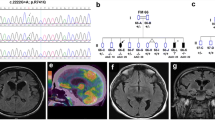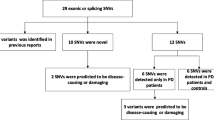Abstract
A recessive mutation in PLA2G6, which is known to cause infantile neuroaxonal dystrophy (INAD) and neurodegeneration associated with brain iron accumulation (NBIA), has recently been shown to be responsible for PARK14-linked dystonia-parkinsonism. To study the frequency of PLA2G6 mutations, including those caused by gene rearrangement in patients with parkinsonism, we performed direct sequencing and investigated copy number variations (CNVs) of this gene in 109 Japanese patients with parkinsonism. Direct sequencing revealed a homozygous mutation (c.1495G>A; p.A499T), which is likely to be pathogenic and is already registered as rs141045127, and two compound-heterozygous mutations we have previously reported. No CNVs in PLA2G6 were detected in our subjects. Our results suggest that CNV in PLA2G6 is rare in parkinsonism, at least in the Japanese population, in contrast to the reports of its frequency in INAD. Further large studies in various populations are warranted to elucidate what causes the difference in frequencies of PLA2G6 rearrangement mutations between INAD and dystonia-parkinsonism.

Similar content being viewed by others
References
Adzhubei IA, Schmidt S, Peshkin L, Ramensky VE, Gerasimova A, Bork P, Kondrashov AS, Sunyaev SR (2010) A method and server for predicting damaging missense mutations. Nat Methods 7(4):248–249. doi:10.1038/nmeth0410-248
Crompton D, Rehal PK, MacPherson L, Foster K, Lunt P, Hughes I, Brady AF, Pike MG, De Gressi S, Morgan NV, Hardy C, Smith M, MacDonald F, Maher ER, Kurian MA (2010) Multiplex ligation-dependent probe amplification (MLPA) analysis is an effective tool for the detection of novel intragenic PLA2G6 mutations: implications for molecular diagnosis. Mol Genet Metab 100(2):207–212. doi:10.1016/j.ymgme.2010.02.009
Gregory A, Westaway SK, Holm IE, Kotzbauer PT, Hogarth P, Sonek S, Coryell JC, Nguyen TM, Nardocci N, Zorzi G, Rodriguez D, Desguerre I, Bertini E, Simonati A, Levinson B, Dias C, Barbot C, Carrilho I, Santos M, Malik I, Gitschier J, Hayflick SJ (2008) Neurodegeneration associated with genetic defects in phospholipase A(2). Neurology 71(18):1402–1409. doi:10.1212/01.wnl.0000327094.67726.28
Gregory A, Polster BJ, Hayflick SJ (2009) Clinical and genetic delineation of neurodegeneration with brain iron accumulation. J Med Genet 46(2):73–80. doi:10.1136/jmg.2008.061929
Gui YX, Xu ZP, Wen L, Liu HM, Zhao JJ, Hu XY (2013) Four novel rare mutations of PLA2G6 in Chinese population with Parkinson’s disease. Parkinsonism Relat Disord 19(1):21–26. doi:10.1016/j.parkreldis.2012.07.016
Hartig MB, Hortnagel K, Garavaglia B, Zorzi G, Kmiec T, Klopstock T, Rostasy K, Svetel M, Kostic VS, Schuelke M, Botz E, Weindl A, Novakovic I, Nardocci N, Prokisch H, Meitinger T (2006) Genotypic and phenotypic spectrum of PANK2 mutations in patients with neurodegeneration with brain iron accumulation. Ann Neurol 59(2):248–256. doi:10.1002/ana.20771
Kumar P, Henikoff S, Ng PC (2009) Predicting the effects of coding non-synonymous variants on protein function using the SIFT algorithm. Nat Protoc 4(7):1073–1082. doi:10.1038/nprot.2009.86
Kurian MA, Morgan NV, MacPherson L, Foster K, Peake D, Gupta R, Philip SG, Hendriksz C, Morton JE, Kingston HM, Rosser EM, Wassmer E, Gissen P, Maher ER (2008) Phenotypic spectrum of neurodegeneration associated with mutations in the PLA2G6 gene (PLAN). Neurology 70(18):1623–1629. doi:10.1212/01.wnl.0000310986.48286.8e
Leclerc GJ, Leclerc GM, Barredo JC (2002) Real-time RT-PCR analysis of mRNA decay: half-life of Beta-actin mRNA in human leukemia CCRF-CEM and Nalm-6 cell lines. Cancer Cell Int 2(1):1
Lee JA, Lupski JR (2006) Genomic rearrangements and gene copy-number alterations as a cause of nervous system disorders. Neuron 52(1):103–121. doi:10.1016/j.neuron.2006.09.027
Morgan NV, Westaway SK, Morton JE, Gregory A, Gissen P, Sonek S, Cangul H, Coryell J, Canham N, Nardocci N, Zorzi G, Pasha S, Rodriguez D, Desguerre I, Mubaidin A, Bertini E, Trembath RC, Simonati A, Schanen C, Johnson CA, Levinson B, Woods CG, Wilmot B, Kramer P, Gitschier J, Maher ER, Hayflick SJ (2006) PLA2G6, encoding a phospholipase A2, is mutated in neurodegenerative disorders with high brain iron. Nat Genet 38(7):752–754. doi:10.1038/ng1826
Paisan-Ruiz C, Bhatia KP, Li A, Hernandez D, Davis M, Wood NW, Hardy J, Houlden H, Singleton A, Schneider SA (2009) Characterization of PLA2G6 as a locus for dystonia-parkinsonism. Ann Neurol 65(1):19–23. doi:10.1002/ana.21415
Salih MA, Mundwiller E, Khan AO, AlDrees A, Elmalik SA, Hassan HH, Al-Owain M, Alkhalidi HM, Katona I, Kabiraj MM, Chrast R, Kentab AY, Alzaidan H, Rodenburg RJ, Bosley TM, Weis J, Koenig M, Stevanin G, Azzedine H (2013) New findings in a global approach to dissect the whole phenotype of PLA2G6 gene mutations. PLoS One 8(10):e76831. doi:10.1371/journal.pone.0076831
Schneider SA, Bhatia KP (2010) Rare causes of dystonia parkinsonism. Curr Neurol Neurosci Rep 10(6):431–439. doi:10.1007/s11910-010-0136-0
Schneider SA, Bhatia KP, Hardy J (2009) Complicated recessive dystonia parkinsonism syndromes. Mov Disord 24(4):490–499. doi:10.1002/mds.22314
Sina F, Shojaee S, Elahi E, Paisan-Ruiz C (2009) R632W mutation in PLA2G6 segregates with dystonia-parkinsonism in a consanguineous Iranian family. Eur J Neurol 16(1):101–104. doi:10.1111/j.1468-1331.2008.02356.x
Tan EK, Ho P, Tan L, Prakash KM, Zhao Y (2010) PLA2G6 mutations and Parkinson’s disease. Ann Neurol 67(1):148. doi:10.1002/ana.21663
Tonelli A, Romaniello R, Grasso R, Cavallini A, Righini A, Bresolin N, Borgatti R, Bassi MT (2010) Novel splice-site mutations and a large intragenic deletion in PLA2G6 associated with a severe and rapidly progressive form of infantile neuroaxonal dystrophy. Clin Genet 78(5):432–440. doi:10.1111/j.1399-0004.2010.01417.x
Untergasser A, Cutcutache I, Koressaar T, Ye J, Faircloth BC, Remm M, Rozen SG (2012) Primer3—new capabilities and interfaces. Nucleic Acids Res 40(15):e115. doi:10.1093/nar/gks596
Yoshino H, Tomiyama H, Tachibana N, Ogaki K, Li Y, Funayama M, Hashimoto T, Takashima S, Hattori N (2010) Phenotypic spectrum of patients with PLA2G6 mutation and PARK14-linked parkinsonism. Neurology 75(15):1356–1361. doi:10.1212/WNL.0b013e3181f73649
Acknowledgements
The authors thank all the participants in this study.
Author information
Authors and Affiliations
Corresponding author
Ethics declarations
Conflict of interest
This work was supported by Grants-in-Aid for Scientific Research (KAKENHI) (to MF, 25461291 and 16K09676, to YL, 25860725 and 16K09700, to HT, 25461292, and to NH, 24390224 and 15H04842) from the Japan Society for the Promotion of Science (JSPS), Grants-in-Aid for Scientific Research on Innovative Areas (to MF 25129707, and to NH, 23111003), a Grant-in-Aid for the Program for the Strategic Research Foundation at Private Universities from the Japanese Ministry of Education, Culture, Sports, Science and Technology (MEXT); and a Health Labour Sciences Research Grant (H26-Nanchitou-Nan-Ippan-085 to NH; H26-Itaku-Nan-Ippan-037 to NH) from the Japanese Ministry of Health, Labour and Welfare (MHLW).
Electronic supplementary material
Below is the link to the electronic supplementary material.
Rights and permissions
About this article
Cite this article
Yamashita, C., Funayama, M., Li, Y. et al. Mutation screening of PLA2G6 in Japanese patients with early onset dystonia-parkinsonism. J Neural Transm 124, 431–435 (2017). https://doi.org/10.1007/s00702-016-1658-7
Received:
Accepted:
Published:
Issue Date:
DOI: https://doi.org/10.1007/s00702-016-1658-7




